Cape Arundel Golf Club
Maine, United States of America

Pound for pound, yard for yard, Cape Arundel ranks with the best expressions of the game in America: proper golf, as the Brits say.
What matters the most to you in a golf course?
The key word is you. Don’t mind what the magazines say or what television blares out. What brings you the most enjoyment and satisfaction?
For the author, the answer is simple, though less easy to obtain. The course must play “fast”; that is the playing surfaces must release the ball and the golfer should enjoy a walk of three hours or so. A well-designed course makes the golfer think – otherwise he isn’t engaged and the day’s worries are unlikely to be left behind. Finally, the golfer should feel a tight bond with nature and if there’s some wind, all the better. Beyond that, not much else matters. The course might be nine holes (the author counts three such course in the world top 100; Culver Academies, Royal Worlington & Newmarket and the Valliere Course at Morfontaine), ten holes (Coore & Crenshaw’s 10 holes at Farmington Country Club in Charlottesville, Virginia), twelve (Shiskine on the Isle of Arran in the Firth of Clyde) or the more conventional, eighteen. Length doesn’t matter so long as the golfer is preoccupied by the adventure – and that requires being asked to hit a wide variety of shots.
Cape Arundel, some thirty minutes south of Portland, Maine, ticks all the boxes that matter most to the author who considers it an ideal design for all to emulate. Others don’t; Golf Digest doesn’t consider it among the top ten in the state – perhaps it flunks the ‘Resistance to Scoring’ metric as the course is ‘only’ 5,859 yards? Fret not – at par 69, stout shots are laced throughout the round. What an immense disservice to the game if a course needs to be 15% or – gasp – 25% (!) longer to be viewed ‘seriously.’
Cape Arundel is routinely enjoyed in under four hours by four (walking!) golfers according to its Golf Professional Ken Raynor, who came to the club in 1974 and was appointed Head Professional in 1979. Closing in on four decades, Raynor has become as much an institution as the 2,000 square foot hunter green clubhouse with its ‘L’ shaped, rocking chair bedecked porch. One of his many rounds with President George H.W. Bush was famously chronicled in the New York Times as lasting but one hour and twenty-four minutes. Apparently, the president had pressing matters but the allure of the course was such that time was carved out for both. His son W (43rd President of the United States) is now a frequent player in the summer months and also very much relishes the quick playing aspects of the course.
Cape Arundel’s challenges stem from the areas 50 yards and in to the greens. What Walter Travis created in 1921 has to rank among the two or three dozen best sets of greens in world golf. The vast majority are open in front but some have bodacious contours, terraces and drop-offs. Travis famously focused on four turning points within his greens (left front quadrant, right front, left back and right back). Oval greens are unlikely on a Travis course. Terraces are liberally applied throughout the putting surfaces as seen in the photograph below. Other greens slope away from the player and a couple are even hidden. The darn twelfth green seems flat until you encounter a back right hole location that breaks opposite to the way you assume. A few targets within the greens seem criminally small for the approach shot. Brendan Parkhurst, the club’s superb Green Keeper, delights in placing the day’s hole locations.
Raynor advises with a smile, ‘Pretend there are no flags – aim for the middle of the greens and you might just have one of your best rounds.’ Chase after a front left hole location on the third, the back right one above or back left on ten and watch your score mount. Raynor noted with pride that the course is known locally as a ‘driver – wedge – bogey.’ Over the years, Raynor has dropped balls around all the greens in an effort to discover the best recovery methods. He likes the idea of letting your wedges ‘talk to you,’ meaning that soft hands are a must and only time and practice will enable you to maximize the bounce and leading edge of your short irons to best advantage.
Located one and half miles from the Atlantic Ocean, playing conditions are ever changing. The Kennebunk River and its fingers border and pierce the property. They are tidal and the wind tends to lay down at ebb but when it’s coming-in, the wind picks up. Raynor’s favorite time is mid-September through mid-October when the firmest surfaces are typical and when the autumn wind tends to arrive producing a shot-maker’s heaven.
With firm breezy conditions, it is important to note the area before many of these greens and how to best use them to reach certain hole locations. Parkhurst states,
The greens approaches receive the same fertility and irrigation inputs as the greens themselves. So, even though we have about 3 acres of putting surface, we are treating a total 6 acres of turf like it is a green. We are very judicious with water usage on these 6 acres as the greens and approaches play their best when they are slightly off color (i.e. brownish). We see it as a personal triumph when we can get our wettest green (13) to wilt. By keeping these areas drier, it means we don’t have to do as much to them to get them firm and fast, therefore reducing the amount of recovery inputs they need throughout the season (If we can roll less and mow at higher heights and still attain our desired green speeds then there is less seasonal wear and tear). Additionally, because our greens are so severely contoured, our daily target speed in 9.5; anything faster and our putting surfaces would be unplayable. Getting to our target speed requires less inputs (and therefore less damage) than if we were shooting for 11 everyday.
Raynor confirms that during his tenure, the club has consistently made strides to promote proper running conditions. That effort received a huge boost forward when the club hired Bruce Hepner as their consulting architect in 1997. According to Hepner,
My first visit to Cape Arundel was in 1994 on a cold call, figuring that it had to be a cool place because the President played there. Nobody had even heard of the place and I just stopped by and somehow met Ken Raynor while walking the course. His 6 year old son, Kyle, had a Pine Valley sweatshirt on and I knew we’d be close friends from that point (as we have). The club hired me in 1997 to develop a Master Plan. The greens were round circles and the place was over-treed and burnt with no fairway irrigation. The turf was no problem but the design certainly needed to be uncovered. I was blown away be the contours of the greens. At that time, no one talked much about Walter Travis and then I realized that he was the author of The Art of Putting. He had to have been an artist to come up with these greens.
At the time of this writing, Hepner has been at Cape Arundel over twenty years. He details the progress that they have made:
My first order was to get the forest under control. We took the wind row of trees and broke them down into clumps (cops) of desirable species. Anything near a putting surface was taken down to open up airflow and the design. Second order was to pour available money into expanding the greens. I told the club if all you had were the best Travis greens in the world, you’d have a great golf course. Let everything else turn brown. Unfortunately the irrigation system was a mess and we couldn’t consistently maintain the expanded greens. So the turf of the expansions suffered for many years, even though you could see the unbelievable contours that were brought back into play.
Then, in 2009 we did a major project that included a complete bunker rebuild, extensive fairway drainage and a new irrigation system. The goal was to have complete turf cover over the entire golf course. Only then would the club enjoy the capability to lean the grass back as the season allowed. The heavy undulations in the fairways had created bird baths and without the drainage, grass would die leaving spotty areas of dirt. With the perfect combination of fairway drainage and irrigation we now have consistent turf grass, that enables a controlled fast and firm environment of golf.
As I told them, you can lean back grass, but can’t lean out dirt. Once we had the complete turf grass cover, we were able to correct the fairway and chipping area mowing lines. This brought all the bunkers back into place/play. While it’s a course that we have intentionally kept under 6,000 yards. the strategic widths are very important in order to choose the correct angle into these complex green sites.
The one thing Hepner didn’t worry about; lengthening the course. As he puts it, ‘Adding 15 yards to a 380 yard hole means nothing to a really good player. It would be a driver and full wedge instead of a gap wedge.’
Shortly after the author visited in May, 2017, Hepner made another site visit. He concluded ‘I couldn’t be happier with the complete turf conditions and the mowing patterns. The irrigation, drainage, and facilities are all contributors, and Brendan is really shining. The course is, in my mind, finally perfect. I told the club that in a note last week. It played perfectly with not one thing out of place.’
The original course was built across farmland in 1896 but failed to arouse much passion. In notes from the board it was referred to as ’embryonic’ and that ‘the old links had outlived their usefulness.’ According to information contained in the club’s wonderful centenary, Our Little Golf Club in Maine, Cape Arundel, attempts were made by the club to have Alex ‘Nipper’ Campbell come up from his position at The Country Club in Brookline, Massachusetts. Alas, there is no such recorded visit. Meanwhile, George H. Walker (yes that Walker who had a cup named after him) was a member of Cape Arundel as well as the President of the Amateur Golf Association (today’s U.S.G.A.). He seems the likely candidate for having the wisdom to recommend and hire Walter Travis in 1920. As a brilliant player, writer, and architect, Travis was surely an imposing golf intellect (even for someone slight in stature). He cajoled the club into acquiring 20 acres across Bass Creek which now house holes 14-18 tee.
What exists today is essentially what Travis created. There is little higher praise. Many of the fairways are laid across fields, green to tee walks are among the shortest in the game and there are no significant climbs. Cape Arundel is Exhibit A1A as a walker’s delight. Where earth was disturbed, it was done so to enhance the golf experience. Travis’s chocolate drop mounds date the course as vintage and thoroughly New England. Little was done to hide the fact that this was farmland. In fact, the twelfth fairway reverted to a cornfield in 1945 in order to assist the war effort.

The idyllic location of the putting green along the banks of the Kennebunk River provides the only the flat putts on the property! Adirondak chairs in the far shadow ooze an appreciation of the outdoors, Maine style.
Hepner and Green Keeper Parkhurst present the course in a flawless manner including mow lines that define wide corridors of fairway-height grass that feed into the rollicking putting surfaces. One sure way to tell how well run a place is by examining its mow lines. When there is thick rough in front, the author has regularly observed a litany of other problems. Typically, such courses/clubs are mislead by low handicap board members who speak of ‘challenge,’ ‘toughness’ and ‘difficulty.’ Cape Arundel is far above that – it is a shot-maker’s dream, and as we see below somewhere that the golfer is free to show his creativity, inventiveness and imagination.
Holes to Note
First hole, 365 yards; What a great handshake to open the course – the Kennebunk River parallels the hole left, there’s a wide fairway ahead (albeit with a gully where you wish it wasn’t) and a green open in front. Hepner states it plainly: ‘If you have great greens, you have a great golf course. Period. Length has nothing to do with it. Every great tour pro has played this golf course as guests of President Bush. The course record stood at 65 forever until recent times when Fred Couples and then Phil Mickelson went really deep. It’s all about the greens. Tom Doak always taught us that anyone can make bold greens but they need to be smart and appropriate for the site and the shot they accept. Here, the bold contours in a small package fit the site perfectly.’
Second hole, 310 yards; The Kennebunk River forks right and trails beside this fairway. As the golfer walks along, he sees a large area of green grass across the river. It’s the club’s practice area and amounts to over 19 acres. Clubs founded pre-1900 gave little thought to ranges (balls were too expensive) but Raynor considers the addition of this practice area in 2010 to be ‘a monumental attribute to the club as so few ancient courses are blessed with such a facility.’
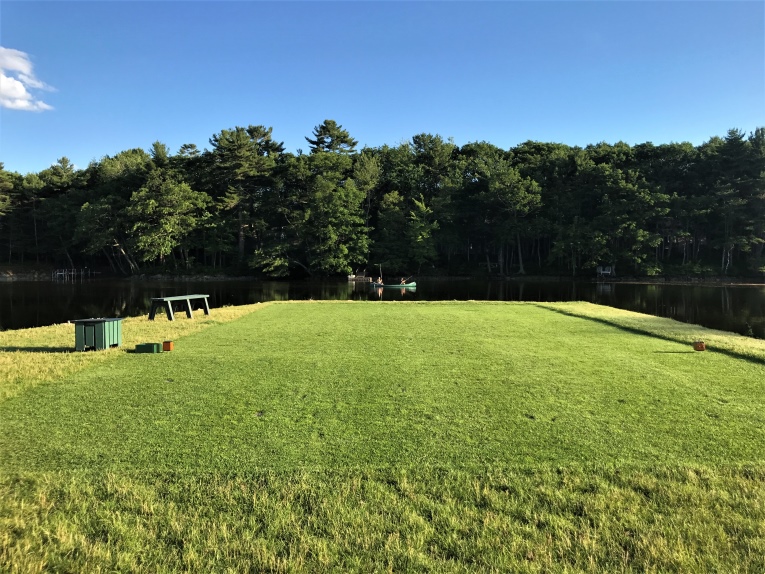
The clean, simple, squared off lines of the tee boxes are hardly noticed by the first timer as he soaks in the view from the tee that occupies high ground at the river’s elbow.
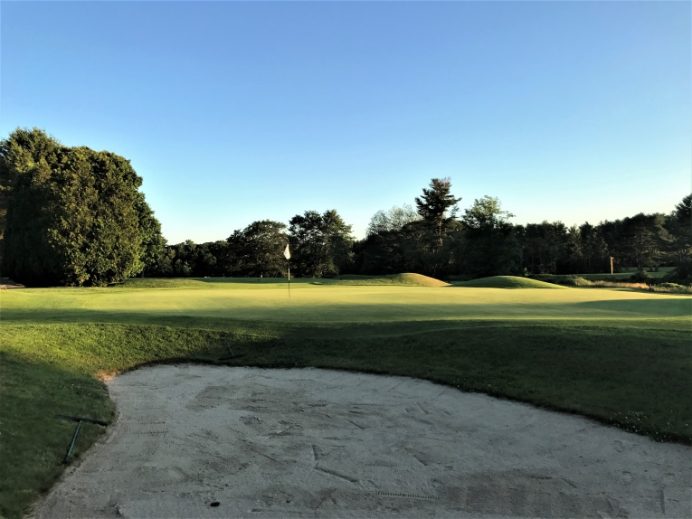
Getting the details right matters: note how the back right of the 2nd green helps balls tumble into the sand. In the mid 1990s, the day’s hole location would have been four feet from the edge of the green. Thanks to the green expansions, the bunkers and greens are now perfectly connected.
Third hole, 155 yards; Here is how this hole was described after Travis’s work: ‘…a gem, and would be considered first class on any of the best golf courses. The shot is a mashie, or a mashie niblic (sic) when the wind is behind, and should be all carry with plenty of backspin, otherwise trouble on all sides and back.’ The author agrees, especially as his mashie niblick came up just short and was rudely sent back some five paces by the false front. In all the world, the author has never had more fun with his hickories.
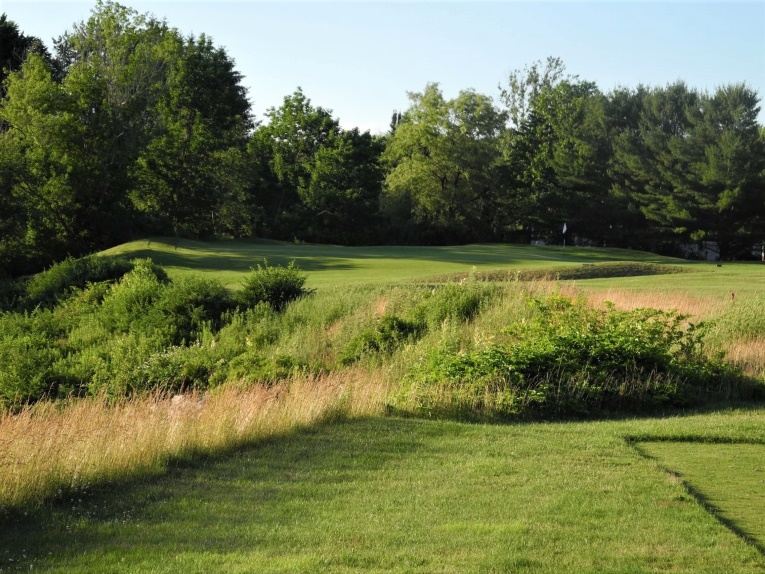
The afternoon shadows mask the severe left false front and that the green falls almost five feet from back to front.
Fifth hole, 340 yards; The prospects of losing a ball other than after a complete duff are rare at Cape Arundel. Forced carries are found when the ball enjoys a perfect lie atop a tee (a.k.a. the second, sixth, eleventh, thirteenth, fourteenth and eighteenth tees). A mild exception occurs here on the approach where a gully bisects the fairway and green making the second strictly aerial. Many consider this one of Maine’s finest holes but, ironically, its aerial approach means that it is not fully representative of the joys of a game at Cape Arundel. Regardless, it is made particularly invigorating by a Travis hump found front center of the green between two fronting bunkers. The club entrance is some seventy yards away. As such, the day’s hole location should be noted in advance. The far left position, pictured above, is best approached from a long right tee ball. Conversely, a hole located on the far right of the green is more easily accessed from the spot from where the photograph below was taken. Interestingly enough, though the hole is under 350 yards, this represents the largest green on the course at 8,300 square feet. Similar to Yale and St. Andrews, no one can adequately explain why it is so perplexingly difficult to get a short iron close on a routine basis to such a large target.

A tantalizing approach across a gully awaits a well-played tee ball. Note the discoloration in the green? That is a puff and hole locations near it are the most exacting, especially those just beyond!
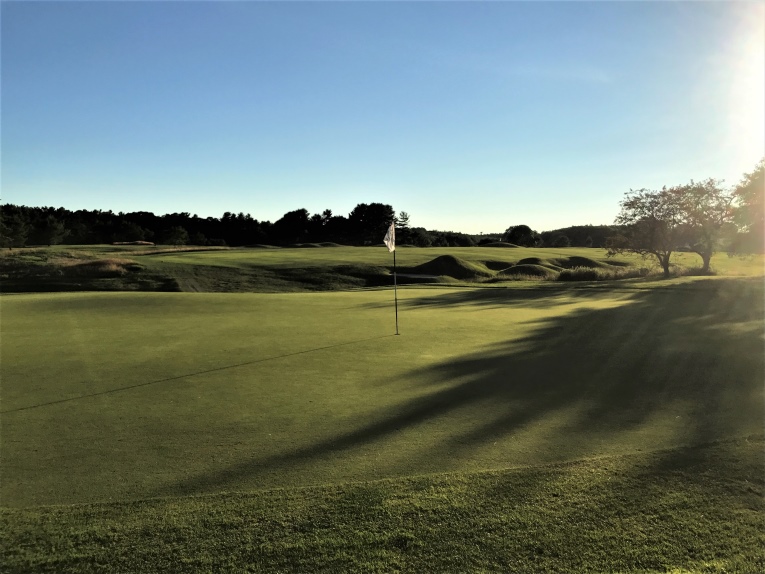
As seen from behind, the nature of the wide green and its puff render a slew of interesting hole locations.
Eighth hole, 380 yards; In some ways, Cape Arundel is depressing to play like two of the author’s absolute favorites, Royal Worlington & Newmarket in England and Wolf Point in Texas. None of the three courses are deemed to be set across rambunctious land but all three appeal immensely thanks to the brain power of man. Take the eighth, where the high to low point on this straight hole is no more than three feet. Yet, sixty yards shy of the center of the green lie two cross bunkers that bifurcate the fairway. Beyond the bunkers lies more fairway and the green pictured below. Voilà – a superb hole created from nothing that would be at home at either the Sacred Nine or Wolf Point. Why can’t more architects in more places create something of similar interest? A fledging architect should know where to go: National Golf Links of America, Oakmont, Pine Valley, Riviera, for sure, but included on a short list of thirty or so courses should be Cape Arundel. With property prices so dear near population centers, architects must become better at packing a punch while using less land. Cape Arundel showcases how to get the absolute maximum from 90 acres. Sadly, Hepner points out, ‘While working for Tom Doak for all those years, he always demanded that we travel and see all the world’s great courses. I could name all the Architects who have visited CA on one hand. You can’t emulate what you haven’t experienced.’

Built across flat land, the eighth hole demonstrates that a minimum elevation change at a judicious moment is all that a hole needs to be special.
Ninth hole, 475 yards; The author is a big fan of par five holes in part because they generally represent an opportunity for the man on his game to get back a shot on Old Man Par. The only negative is that they take longer to play than a one or two shotter. Alas, one of the reasons that the Cape Arundel is so quick-playing is that this is the course’s sole par five. Hence, par is a “measly” 69. In New England, the most famous par 69 is Wannamoisset, some 180 miles south in Rhode Island. It hosts one of the country’s most prestigious amateur events each year and is always up to the task. Among other reasons, its dirth of par fives gives the bomber scant opportunity to overwhelm the course. A similar rationale applies at Cape Arundel. If the course had three additional par fives, it might measure some 300-400 yards longer – and be much easier. This hole occupies the playing corridor of the original finishing hole from the 1896 design, albeit with plenty of enhancements from Travis as we see below.
Tenth hole, 335 yards; Few holes better demonstrate how a sub-350 yarder can infuriate even the most polished player. Fescue covered mounds right off the tee and the unfelt breeze that flows straight up the river off the Atlantic add to the challenge of one of the game’s great putting surfaces. This open hole also epitomizes the more links like feel that has been promoted over the past twenty years. Trees are down, fescue grasses up, and so too is the effect of the wind as it whistles uninterrupted across much of the property. Borrowing again from Our Little Golf Club in Maine, Cape Arundel, Travis once sent a letter to the club that states: ‘While the course plays on the ‘short side’ – and rightly so, seeing that it is a ‘resort’ course, principally – yet it will strongly appeal to every class of golfer, from the ‘crack’ to the ‘dub.’ It looks easy, as my courses do, but the man who equals par will have played some ‘golf.’ The real difficulties in the scientific placements of hazards, all arranged not for the ‘dub,’ but for the fairly good shots of the player which are not quite good enough. Yet, no single hazard borders on unfairness.’ The message in that quote resonates here as copious amounts of short grass are provided left for the ‘dub’ while the ‘crack’ player seeking the short way home must contend with fescue covered mounds down the right.
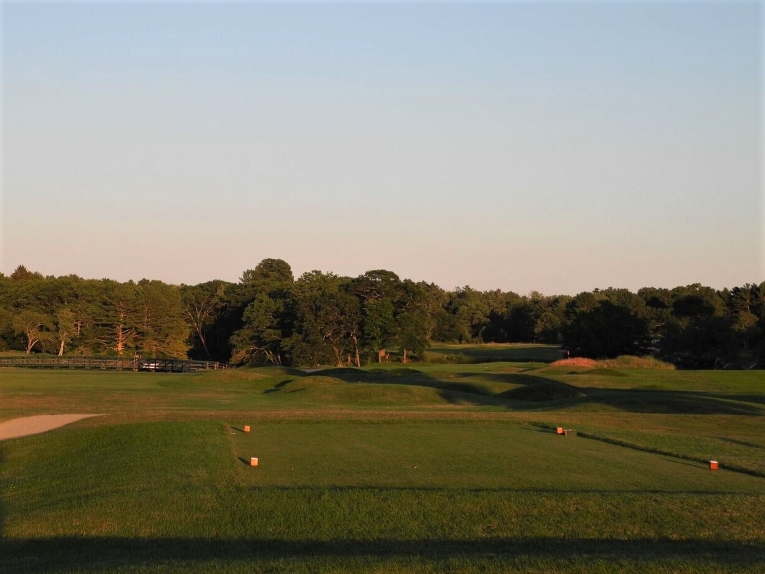
The tenth bends around a series of mounds with its flag visible well to the right over the fescue covered mound.
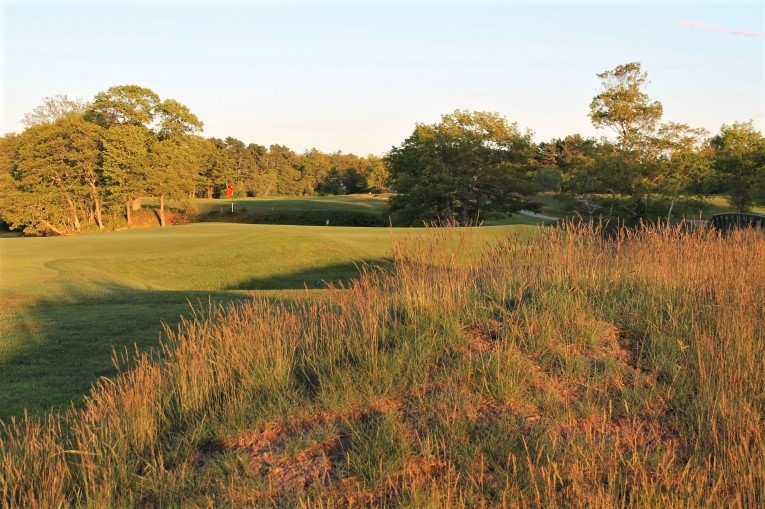
The textures and hues across the course readily appeal. At 4700 square feet, the green is the smallest target on the course and its undulating surface wreaks havoc.
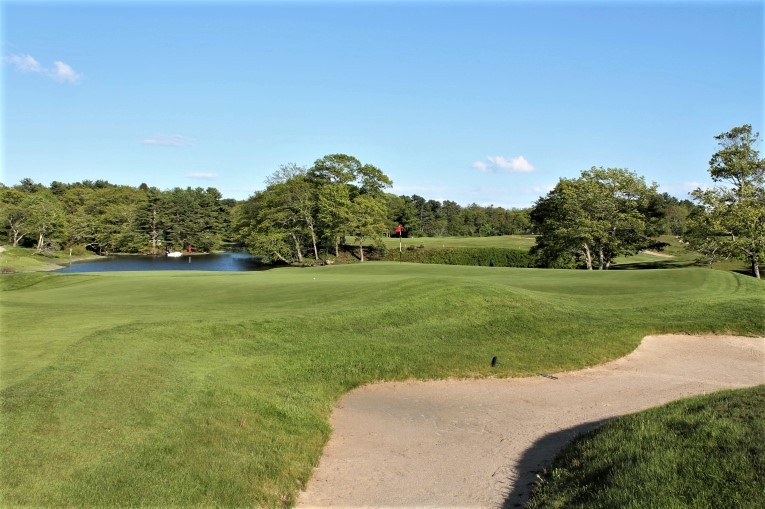
Travis thought that the game began and finished on the green and that is made evident by this roly-poly putting surface. Seen above is its diabolical back left hole location on what is optimistically deemed a shelf.
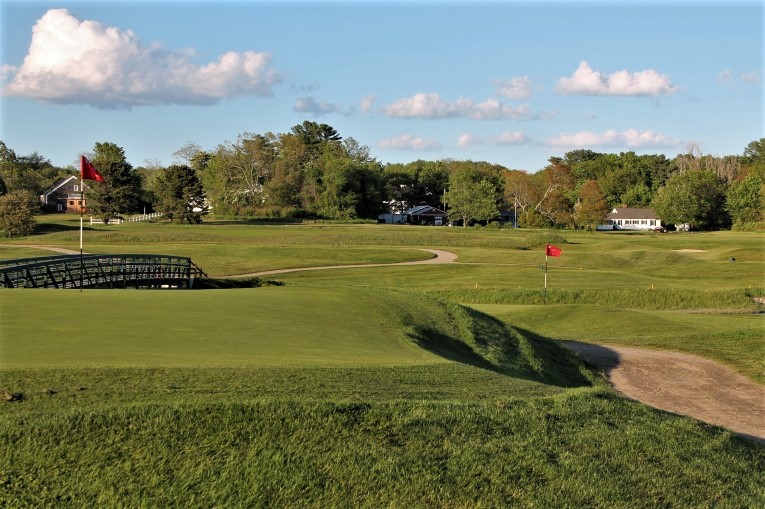
As seen from back right, Green Keeper Parkhurst can turn a drive and pitch hole into a survival of the fittest based on his choice of hole locations.
Eleventh hole, 340 yards; The author wishes he knew more about the 1896 course which apparently used this playing corridor at a time when there weren’t many interesting diagonal tee shots. Regardless, like the ninth, Travis’s enhancements are what make the approach so interesting. Travis once wrote, ‘Out of the eighteen greens, I would suggest three fairly flat, two or three gently sloping, one or two on the punch-bowl order, two or three of the plateau type, and the rest more or less undulating.’ This marvelous green complex is of the punch-bowl type.
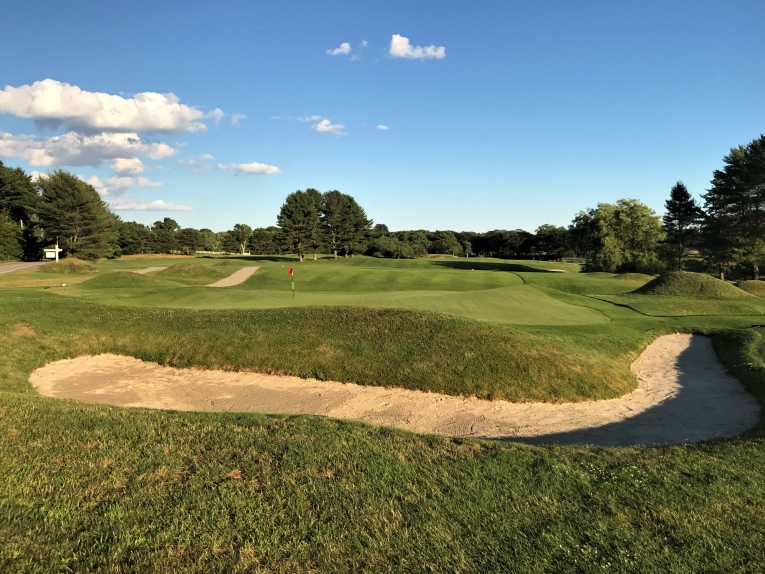
As seen from behind, the old school nature of Travis’s bunkers and mounds time-stamp the course as Golden Age.
Thirteenth hole, 165 yards; Why this is a favorite of 41 and Raynor is glaringly obvious from the tee where the hole enjoys a wonderfully natural setting at a fork in the river. While the property might be mostly flat, the first time golfer won’t readily think so driving away. He is far more apt to recall the exciting moments created by playing along and over river banks. Travis routed the eighteen holes so darn well and took maximum advantage of everything that nature provided.
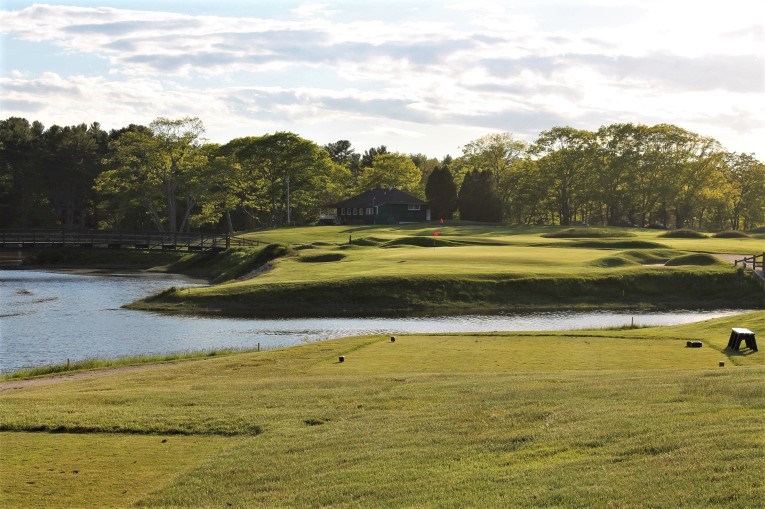
Mounds right, a false front, water left and wind define the challenge at the one shot 13th. This is one of the windiest spots on the course so seeing the red flag at attention is no surprise.
Fourteenth hole, 385 yards; Raynor makes the interesting observation that much of the trouble at Cape Arundel is found on the left side of holes. In fact, he notes that an expression ‘Cape Arundel Block’ exists because golfers hang on a bit at the bottom of the swing to prevent a shot from going left. This hole is a case in point. The seventeenth fairway isn’t too far way on the right but on the left side of the fairway trees overhang an offshoot of the river. Another brilliant ‘open in front’ green awaits.
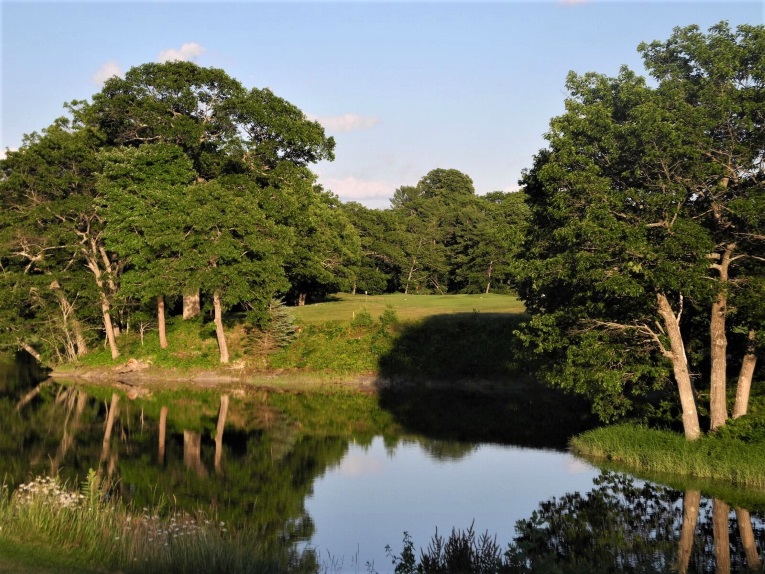
Over its 120 + year history, today’s first, tenth and fourteenth have at one time been the opening hole. Given the uncompromising nature of the forced carry here, this is the author’s least favorite ” opener.” It plays much better as a swing hole in the middle of a tight match on the back nine.
Seventeenth hole, 360 yards; People who think blind holes don’t require good golf or aren’t strategic need to play this one. Both the tee and fairway are in a field making the drive open and inviting. The fairway is bunkerless – until sixty yards short of the green, where the hole’s sole hazard is nestled at the break of a hill. Twenty feet below lies the green and the flag is likely invisible for one’s approach. Like to so many holes at Cape Arundel, it is the land fronting the green that defines the golf. In this case, Raynor makes it clear that only approach shots played from the center of the fairway enjoy a straight, generally predictable kick forward. Played from the rough on either side, the approach will hit near the green at an angle and bounce awkwardly.
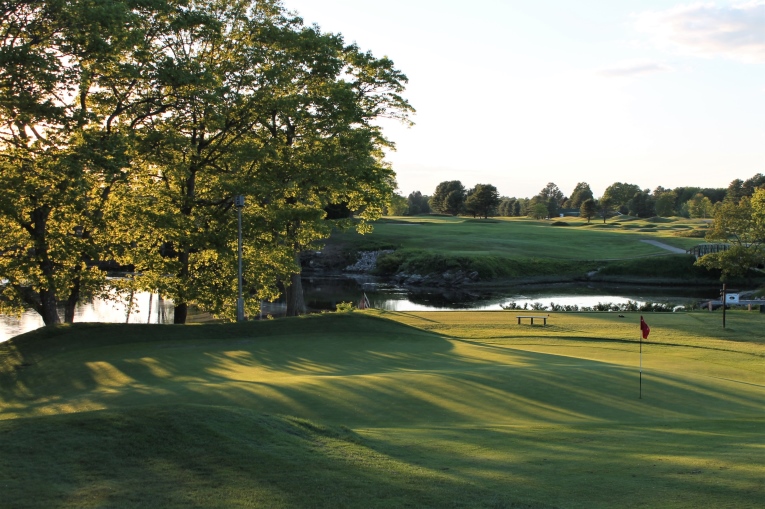
My goodness – the green literally cascades down the natural grade. The glorious panorama of the 18th fairway unfolds beyond.

As seen from behind, the fairway feeds directly onto the putting surface and is the golfer’s friend only if he drives it straight. The drop from the front of the putting surface to the back is nearly four feet!
Eighteenth hole, 395 yards; A terrific finish, this uphiller plays the longest of the two shotters. The Kennebunk River is crossed for the fourth and final time off the tee. Ahead, the golfer takes aim at the tree-framed green but only after he has made sure that no one is on the entrance drive eighty yards shy of the putting surface.
The author frequently worries about the American game that takes too long, costs too much, and often is too little fun. Such worries melt away when one drives up Cape Arundel’s winding entrance. Perhaps the club’s close proximity to the United Kingdom and Ireland helps explain why so many common sense elements there are so pervasive here. Clubs in the lower states could learn volumes if they sent representatives to tour such charm-laden designs like Prouts Neck, Kebo Valley and here.
According to Michael Moore, Secretary of the Maine State Golf Association, ‘As a founding member of the MSGA, as the home club of George Herbert Walker and his descendants, and as an architectural time capsule showing the genius of Walter Travis, Cape Arundel is vital to Maine golf. The simple clubhouse, the battered locker room, and the modesty seen in the parking lot all show that Cape Arundel is almost entirely about golf, friendships, and the humility that is required for each.’
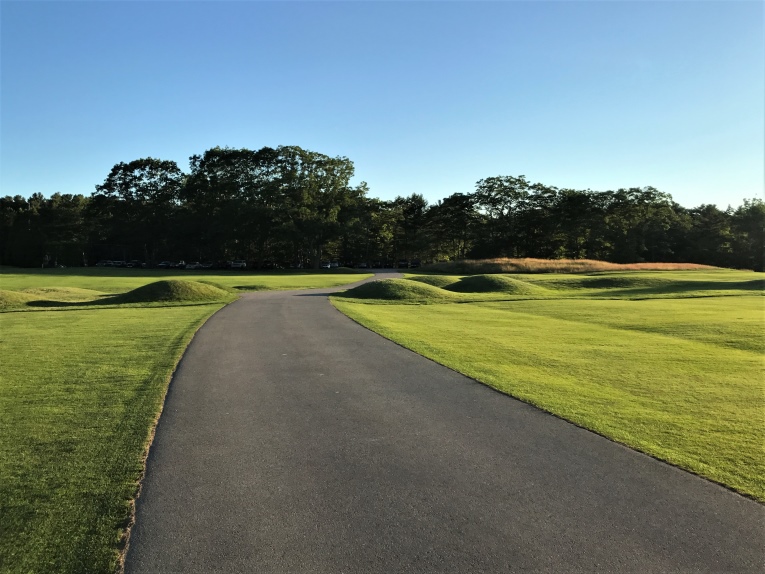
The entrance weaves through the course and Travis’s mounds. As soon as you turn onto it, you know your day is about to improve.
Thankfully, this sub-6000 yard course will never harbor aspirations of hosting a professional event or anything else that might suggest an alteration to the course. It is perfect ‘as-is.’ Define what is truly important about this game and see if you don’t agree.
The End
The author wishes to thank Michael Moore for some of his photographs in this course profile.


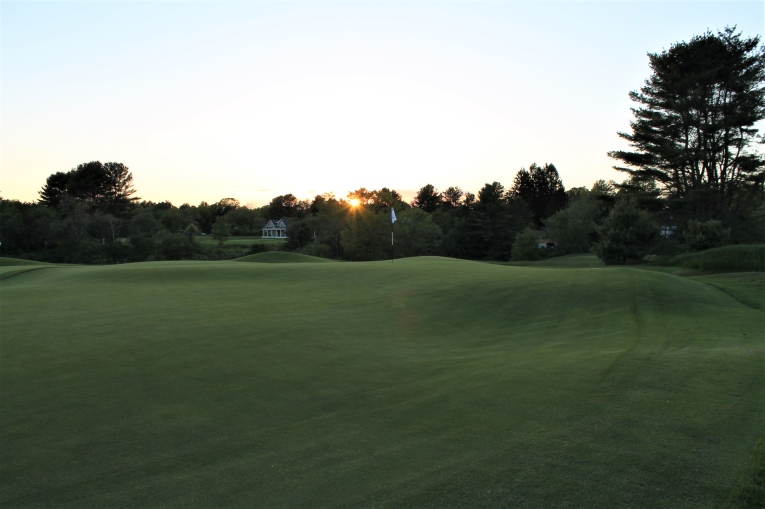
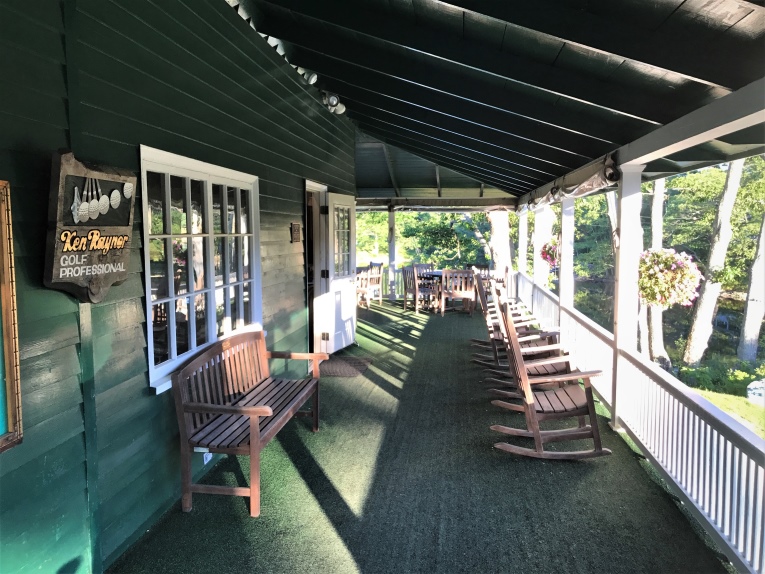

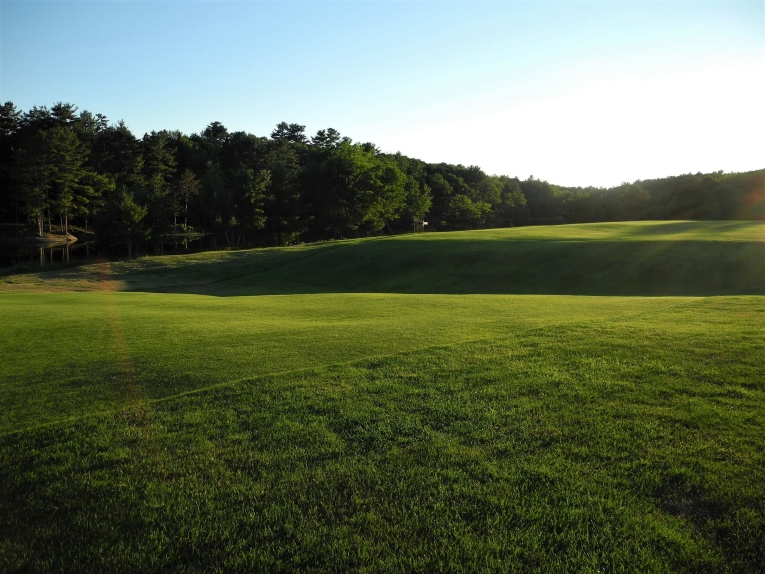
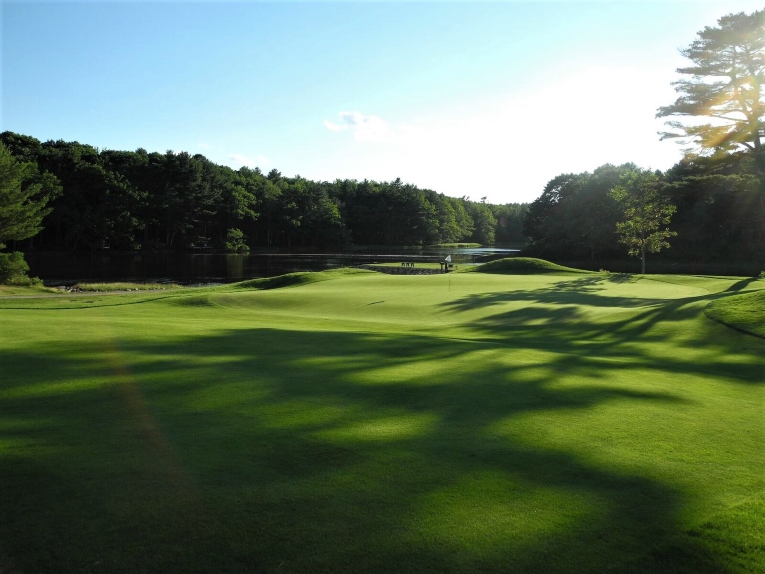

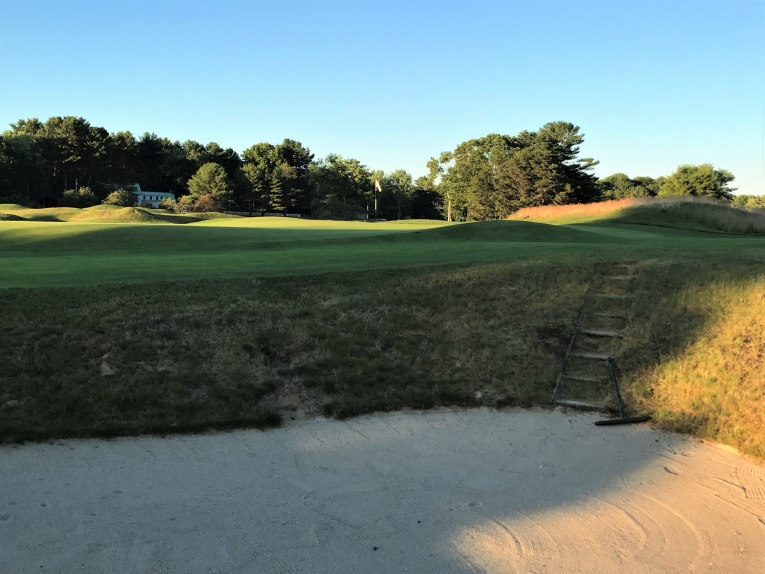
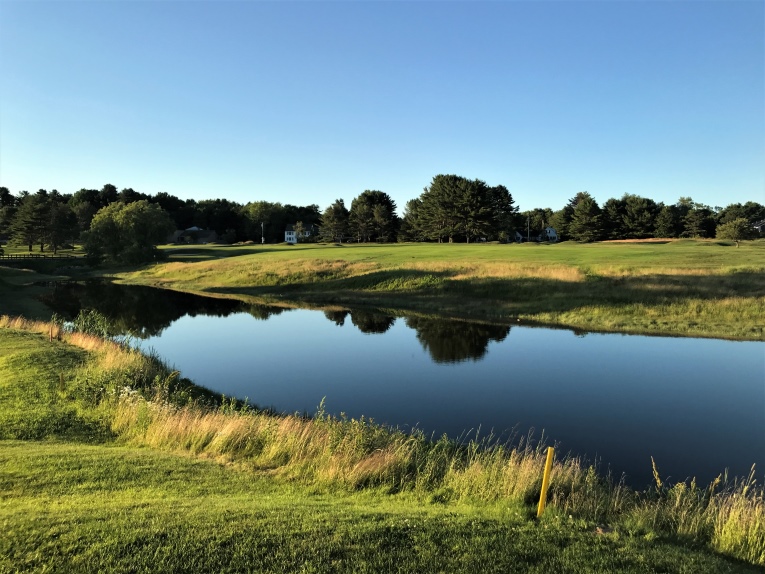






![The Park, West Palm (Lit 9) [2023]](https://golfclubatlas.com/wp-content/uploads/2024/12/IMG_7092-2-scaled-500x383.jpg)


